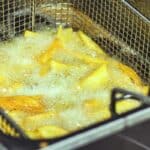Induction cooktops, or portable electric stoves as they are commonly called, are exciting new cooking appliances that are making waves everywhere, but how to use them can be confusing to some.
Due to their user-friendly design and compact size, these induction cooktops can be used almost anywhere. We’re going to assume that you’re already on board with the idea of induction cooktops since you’re already here. We also have compiled a guide that will help you choose portable electric stove, if you are looking for the best one.
The only downside is that these stoves are still relatively new on the market, so users will need to learn the best way to use them in different locations and for various types of cooking. No need to worry, we’ve all struggled with this prospect, but keep reading, and you’ll catch up from there!
How to Use Portable Electric Stove
Adjusting the Power and Temperature Levels
Induction cooktops come with a control panel, which is naturally their primary focus. For more advanced models, you’ll find a pretty detailed digital control panel on the cooktop.
You can now turn on the stove and set it to your desired temperature. You will probably find a display that shows the temperature that is currently set on your stove. There are usually plus or minus signs that can be used to increase or decrease the temperature.
For safety reasons, there will also be a light to indicate when the stove is on. Other controls, or even custom settings, may also be available depending on the model of your stove. There may be a separate control for defrosting frozen foods, for example.
Keeping the Cooktop Clean
When the stove is in use, it should be one of your top priorities to keep the cooktop clean. It is best to take preventive measures such as using a lid to prevent food droplets from escaping.
For foods that are prone to boiling over, such as milk, use a low to moderate temperature to prevent making a mess. Being safe is better than being sorry. Clean the bottom of your cookware as well to keep the stove clean and to ensure even heating.
Some electric stoves come with detachable burner coils, so you can clean the cooktop without disturbing the coils. Clean ceramic glass cooktops with non-abrasive sponges or a soft cloth after use, and you should be good to go!
You Should Use Proper Cookware
Cookware is essential if you want to maintain the performance and durability of your electric stove as well as get the best results. The burners of most good quality cooktops can handle a wide range of cookware, including copper pans, aluminum, cast iron, and stainless steel.
If you buy another brand, you might have to purchase custom cookware to go with the stove, but the choice is yours. You should definitely invest in custom cookware if you believe they are worth the money. Otherwise, choose the ones that are compatible with the cookware you already own.
Different Settings for Different Types of Cooking
With most advanced cooktops, you have quite a few settings to choose from, from different power settings to temperature settings. The main purpose of these settings is to make the cooking range compatible with multiple cooking methods.
This information can vary from one model to another, so it is best to consult the user manual included with your stove in order to get it first-hand.
You may also look up related videos online or contact customer care if you need further assistance.
How Does Induction Cooking Work?
In thermal induction, a flame or an electric implement generates heat that, in turn, heats up the cookware when it’s placed on top. On the other hand, an induction cooktop uses electromagnetic induction to turn the pan itself into a heat source. (The cooktop itself hardly warms up at all, after removing a pot of boiling water, it is warm to the touch, but hardly scorching hot when compared to a gas stove.)
Induction cooktops work by passing an electric current through copper coils to the iron in cookware (note that not all cookware works on induction ranges), and because iron is a poor conductor, the electricity is converted to heat in the pan.
Induction burners typically have a power level (numbered and corresponding to a specific wattage ranging from 100 watts to 1800 watts) as well as a temperature setting ranging from 100°F to 500°F. An induction cooktop designed for home use can be plugged into a 120-volt outlet, which is standard in the US. (However, many recommend not plugging in more than one cooktop at a time into the same outlet.)
The drawbacks of induction cooking are mainly related to the types of cookware you can use; induction stoves require compatible cookware. Induction compatible cookware must be made from ferrous material, such as cast-iron, iron, steel, or stainless steel with a magnetic base (not all 18/10 stainless steel will work, nor will glass, ceramic nonstick, copper, or aluminum). Flat cookware is required, so woks don’t work, and pans smaller than 4 inches or so in diameter, like little butter melters, may not connect. Moreover, without an open flame like a gas burner, you can’t blacken a bell pepper on a stovetop or crisp a sheet of nori by waving it over the heat (but you can use a broiler to do these things). Be sure to keep items that are sensitive to magnetism away from the cooktops.
Was this helpful?
Hi there! I’m a food enthusiast and journalist, and I have a real passion for food that goes beyond the kitchen. I love my dream job and I’m lucky enough to be able to share my knowledge with readers of several large media outlets. My specialty is writing engaging food-related content, and I take pride in being able to connect with my audience. I’m known for my creativity in the kitchen, and I’m confident that I can be the perfect guide for anyone looking to take their culinary journey to the next level.








